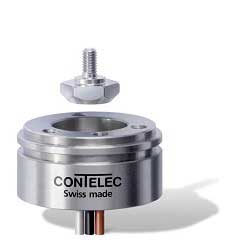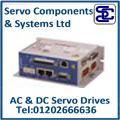
Posted to News on 9th Apr 2010, 10:59
Advantages of non-contact magnetic rotary sensors
This article from Variohm-EuroSensor explains how non-contact rotary sensors can benefit some types of application.

Whether because of axial offsets, excessive torque or the necessity for transmissive measurements, conventional angle sensors are not suitable for all applications. However, non-contact rotary sensors with offset magnetic transducers can offer benefits in applications where other types of sensor are unsuitable.
It is not always the case that reliable linkage of an angle sensor to the self-rotating element is straightforward, as is clearly illustrated in applications such as those where there are axial offsets between the customer's rotating component and the sensor axis, attributable to design features and manufacturing tolerances. High-resolution, precision rotary sensors tolerate no torsion of the linkage and, when this is in evidence, it has a negative influence on the measured results, since a twist of the axis generates erroneous angle data. Despite this fact, there are still a host of 'over-engineered' designs that can be encountered in practical applications, in which there is rigid linkage between the sensor axis and the rotating element supplied by the customer. Systems of this kind can suffer a number of problems, including increasing mechanical wear of the sensor bearings and fracturing of the sensor axis.
New degrees of freedom

Non-contact rotary sensors are based on a magnetic, contactless sensor principle. They are, therefore, wear-free and extremely tolerant of external influences, yet they demonstrate an impressively long life, precision and resolution. They are available both as standard components and as customer-specific designs and, depending on the version, have tolerances of several millimetres in terms of axial offsets. They also boast convincing performance features, such as maximum 14-bit resolution and 10-bit precision at a linearity of 0.3 per cent.
Transmissive and torque-free
Non-contact rotary sensors are not just suitable for applications with axial offsets (XYZ tolerances); they are also suitable for other tasks that are very difficult - or even impossible - to implement with conventional rotary sensors. These include transmissive measurements, in which it is necessary to measure an angle through a liquid or solid material.
A further area can be found in applications in which minimum torque is essential - for example in devices for measuring wind direction. Hitherto, instruments of this type have required expensive sensors and bearing systems to achieve torque levels as low as 0.002-0.003Ncm. This is an application for which non-contact sensors are highly suitable, since the mechanical separation of the sensor and permanent magnet ensures that there is no torque (no rotary axis bearings - and consequently no friction). The new sensors even enable the redundant systems to be implemented cost-effectively and without significantly increasing torque. With existing rotary sensors with jewel bearings, it has not been possible to improve on torque levels of 0.004-0.006Ncm. Another deficiency of conventional low-torque systems is their inadequate seal tightness for a large number of applications. In many cases, the maximum protection class is IP60, since, at any higher values, the O-ring would effect an excessive increase in the torque. Non-contact rotary sensors, however, enable high-protection sensors to be constructed because the only part of the sensor that needs sealing is the one on which there are no moving components.
In contrast to conventional low-torque angle sensors, which require an intricate manufacturing process and expensive materials, another attractive feature of non-contact rotary sensors is their price. The simpler construction leads to a significant reduction in production costs - and, consequently, considerably lower prices.
Countering interference fields
In applications requiring a low-torque angle sensor, the earth's magnetic field comes into play. This acts on the permanent magnet, trying to align it with the north-south magnetic poles and, by doing so, imposes a torque on the magnet. However, in the case of small permanent magnets with simple dipole magnetisation, this torque is in the order of magnitude of 0.0002Ncm and is therefore generally non-critical. A considerably greater influence can be exerted by static or dynamic magnetic fields generated by external sources.
Motors, live coils or permanent magnets positioned nearby can interfere with magnetic non-contact rotary sensors. It is therefore important to screen the sensors from interference fields by surrounding the magnet and sensor with a material that conducts magnetic flux. To ensure that the performance of the sensor is not impaired, this material has to have special properties; the use of a simple magnetic steel sheet is frequently insufficient for this purpose.
The precision of the sensor can also be influenced by electrical interference fields. These can be screened by an electrically conductive body, though this does not eliminate line-linked interference that penetrates into the sensor through the cables. Protection against interference of this kind is primarily provided by suitable electrical circuit elements. Appropriate EMC tests must be carried out to ensure that the sensors are suitable for the required conditions.
Overcoming existing limits
Some benefits that make noncontact and contactless rotary sensors so valuable are shared by optical encoders. However, these advantages are frequently eliminated by major disadvantages, such as size, price, possible fogging and breakage of the code disk. In contrast, the latest generation of magnetic angle sensors achieve specifications that would be inconceivable with optical systems. These include miniature sensors with weight-optimised magnets and magnet carriers with impressively low external diameters of just 13mm, resolutions of up to 14-bit and precision of up to 10-bit. Sensors are also available that are particularly suited to heavy-duty applications, which are not susceptible to intense vibrations and impacts. A key feature here is that, in addition to standard products, products with customised performance specifications and designs can be manufactured. They differ in aspects such as body shape, magnetic transducer, distance between the permanent magnet and the measurement system and permitted tolerances. Devices with body diameters from 13-37mm, resolutions of up to 14-bit, IP69K-sealed versions and versions for the temperature range between -40 and +125degC are available as both standard components and custom designs.
In addition, a range of different connection technologies and output signals make an important contribution to application-orientated customisation. Available options include analogue outputs, with various voltage and current levels, and digital interfaces such as PWM, SPI or SSI. Connection can be by stranded wire, straight cable or pin-connector packages. Other advantages of magnetic rotary sensors include the possibility of free programming of the rotary angle from 0 to 360degrees. A remarkable feature here is that the full resolution and precision are available even at angles less than 360 degrees. Some sensors even enable individual configuration of the direction of rotation and the index point.
Want the latest machine building news straight to your inbox? Become a MachineBuilding member for free today >>


















